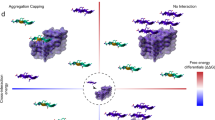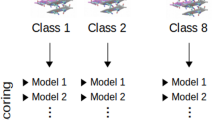Abstract
We have developed a statistical mechanics algorithm, TANGO, to predict protein aggregation. TANGO is based on the physico-chemical principles of β-sheet formation, extended by the assumption that the core regions of an aggregate are fully buried. Our algorithm accurately predicts the aggregation of a data set of 179 peptides compiled from the literature as well as of a new set of 71 peptides derived from human disease-related proteins, including prion protein, lysozyme and β2-microglobulin. TANGO also correctly predicts pathogenic as well as protective mutations of the Alzheimer β-peptide, human lysozyme and transthyretin, and discriminates between β-sheet propensity and aggregation. Our results confirm the model of intermolecular β-sheet formation as a widespread underlying mechanism of protein aggregation. Furthermore, the algorithm opens the door to a fully automated, sequence-based design strategy to improve the aggregation properties of proteins of scientific or industrial interest.
This is a preview of subscription content, access via your institution
Access options
Subscribe to this journal
Receive 12 print issues and online access
$209.00 per year
only $17.42 per issue
Buy this article
- Purchase on Springer Link
- Instant access to full article PDF
Prices may be subject to local taxes which are calculated during checkout



Similar content being viewed by others
References
Chiti, F. et al. Studies of the aggregation of mutant proteins in vitro provide insights into the genetics of amyloid diseases. Proc. Natl. Acad. Sci. USA 99, 16419–16426 (2002).
Chiti, F., Stefani, M., Taddei, N., Ramponi, G. & Dobson, C.M. Rationalization of the effects of mutations on peptide and protein aggregation rates. Nature 424, 805–808 (2003).
Chiti, F. et al. Kinetic partitioning of protein folding and aggregation. Nat. Struct. Biol. 9, 137–143 (2002).
Dobson, C.M. The structural basis of protein folding and its links with human disease. Philos. Trans. R. Soc. Lond. B 356, 133–145 (2001).
Dobson, C.M. Protein-misfolding diseases: getting out of shape. Nature 418, 729–730 (2002).
de la Paz, M.L. & Serrano, L. Sequence determinants of amyloid fibril formation. Proc. Natl. Acad. Sci. USA 101, 87–92 (2004).
Ramirez-Alvarado, M., Blanco, F.J., Niemann, H. & Serrano, L. Role of beta-turn residues in beta-hairpin formation and stability in designed peptides. J. Mol. Biol. 273, 898–912 (1997).
Lopez de la Paz, M., Lacroix, E., Ramirez-Alvarado, M. & Serrano, L. Computer-aided design of beta-sheet peptides. J. Mol. Biol. 312, 229–246 (2001).
Vassar, R. et al. Beta-secretase cleavage of Alzheimer's amyloid precursor protein by the transmembrane aspartic protease BACE. Science 286, 735–741 (1999).
Caughey, B. & Lansbury, P.T. Protofibrils, pores, fibrils, and neurodegeneration: separating the responsible protein aggregates from the innocent bystanders. Annu. Rev. Neurosci. 26, 267–298 (2003).
Nilsberth, C. et al. The 'Arctic' APP mutation (E693G) causes Alzheimer's disease by enhanced Abeta protofibril formation. Nat. Neurosci. 4, 887–893 (2001).
McCutchen, S.L., Lai, Z., Miroy, G.J., Kelly, J.W. & Colon, W. Comparison of lethal and nonlethal transthyretin variants and their relationship to amyloid disease. Biochemistry 34, 13527–13536 (1995).
Pepys, M.B. et al. Human lysozyme gene mutations cause hereditary systemic amyloidosis. Nature 362, 553–557 (1993).
Almeida, M.R., Alves, I.L., Terazaki, H., Ando, Y. & Saraiva, M.J. Comparative studies of two transthyretin variants with protective effects on familial amyloidotic polyneuropathy: TTR R104H and TTR T119M. Biochem. Biophys. Res. Commun. 270, 1024–1028 (2000).
Hammarstrom, P., Schneider, F. & Kelly, J.W. Trans-suppression of misfolding in an amyloid disease. Science 293, 2459–2462 (2001).
Quintas, A., Saraiva, M.J. & Brito, R.M. The amyloidogenic potential of transthyretin variants correlates with their tendency to aggregate in solution. FEBS Lett. 418, 297–300 (1997).
Shnyrov, V.L. et al. Comparative calorimetric study of non-amyloidogenic and amyloidogenic variants of the homotetrameric protein transthyretin. Biophys. Chem. 88, 61–67 (2000).
Canet, D. et al. Local cooperativity in the unfolding of an amyloidogenic variant of human lysozyme. Nat. Struct. Biol. 9, 308–315 (2002).
Morozova-Roche, L.A. et al. Amyloid fibril formation and seeding by wild-type human lysozyme and its disease-related mutational variants. J. Struct. Biol. 130, 339–351 (2000).
Chamberlain, A.K., Receveur, V., Spencer, A., Redfield, C. & Dobson, C.M. Characterization of the structure and dynamics of amyloidogenic variants of human lysozyme by NMR spectroscopy. Protein Sci. 10, 2525–2530 (2001).
Booth, D.R. et al. Instability, unfolding and aggregation of human lysozyme variants underlying amyloid fibrillogenesis. Nature 385, 787–793 (1997).
Guerois, R., Nielsen, J.E. & Serrano, L. Predicting changes in the stability of proteins and protein complexes: a study of more than 1000 mutations. J. Mol. Biol. 320, 369–387 (2002).
Lacroix, E., Viguera, A.R. & Serrano, L. Elucidating the folding problem of alpha-helices: Local motifs, long-range electrostatics, ionic-strength dependence and prediction of NMR parameters. J. Mol. Biol. 284, 173–191 (1998).
Blanco, F.J. & Serrano, L. Folding of protein G B1 domain studied by the conformational characterization of fragments comprising its secondary structure elements. Eur. J. Biochem. 230, 634–649 (1995).
Luo, P. & Baldwin, R.L. Mechanism of helix induction by trifluoroethanol: a framework for extrapolating the helix-forming properties of peptides from trifluoroethanol/water mixtures back to water. Biochemistry 36, 8413–8421 (1997).
Naiki, H. & Nakakuki, K. First-order kinetic model of Alzheimer's beta-amyloid fibril extension in vitro. Lab. Invest. 74, 374–383 (1996).
Mathews, B.W. Comparison of predicted and observed secondary structure of t4 phage lysozyme. Biochim. Biophys. Acta 405, 442–451 (1975).
Acknowledgements
We thank Jesper Borg for helpful discussions. We are also grateful to Fabrizio Chiti for pointing us to data on amyloid forming sequences. J.S. and F.R. held a Prize Traveling Fellowship of the Wellcome Trust while at EMBL. A.M.F.E. was funded through a Marie Curie Fellowship from the European Union. This work was partly supported by an EU Training and Mobility of Researchers grant (EU Network on amyloid fibril formation, CT2-00241).
Author information
Authors and Affiliations
Corresponding author
Ethics declarations
Competing interests
The authors declare no competing financial interests.
Supplementary information
Supplementary Fig. 1
Control measurements on the aggregation of peptides. (PDF 85 kb)
Supplementary Table 1
Dataset derived from literature: Comparison between TANGO predicted aggregation and experimental information available in the literature on peptides derived from 21 proteins. (PDF 143 kb)
Supplementary Table 2
Dataset measured in our laboratory: Comparison between TANGO aggregation score and newly acquired experimental data using CD spectroscopy on the aggregation of peptides derived from the sequence of human prion protein, human lysozyme and β-microglobulin. (PDF 74 kb)
Rights and permissions
About this article
Cite this article
Fernandez-Escamilla, AM., Rousseau, F., Schymkowitz, J. et al. Prediction of sequence-dependent and mutational effects on the aggregation of peptides and proteins. Nat Biotechnol 22, 1302–1306 (2004). https://doi.org/10.1038/nbt1012
Received:
Accepted:
Published:
Issue Date:
DOI: https://doi.org/10.1038/nbt1012
This article is cited by
-
Cryo-EM observation of the amyloid key structure of polymorphic TDP-43 amyloid fibrils
Nature Communications (2024)
-
Disease-specific tau filaments assemble via polymorphic intermediates
Nature (2024)
-
Staphylococcal superantigen-like protein 10 enhances the amyloidogenic biofilm formation in Staphylococcus aureus
BMC Microbiology (2023)
-
Widespread amyloidogenicity potential of multiple myeloma patient-derived immunoglobulin light chains
BMC Biology (2023)
-
Network of hotspot interactions cluster tau amyloid folds
Nature Communications (2023)



